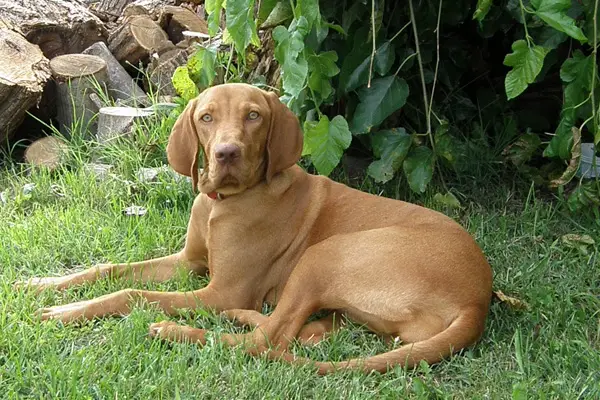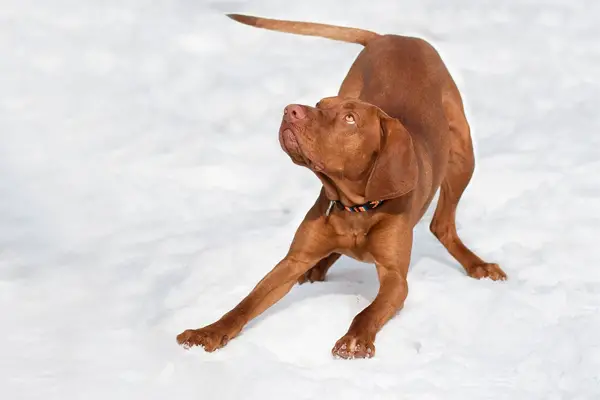Vizslas are often called “Velcro Vizslas” because they are extremely attached to their humans. They feature a lean body covered with a sleek, golden rust coat. The Vizsla has a long, silky ears that frame their sensitive but loving facial expression.
Vizslas form tight bonds with their owners, which makes them excellent family dogs. They are also excellent hunting, sports, and even therapy buddies if you need one. It’s best to take note that this dog breed is not for everyone. They need your utmost attention, and they’ll surely get lonely if left alone.

Vizsla Statistics
| Dog Breed Group | Sporting |
| Breed Size | Medium |
| Height | 22-24 inches (male); 23-23 inches (female) |
| Weight | 55-60 pounds (male); 44-55 pounds (female) |
| Lifespan | 12-14 years |
Vizsla Ratings
| Energy level | |
| Exercise needs | |
| Requires attention | |
| Playfulness | |
| Trainability | |
| Shedding | |
| Grooming | |
| Friendly with family | |
| Friendly with kids | |
| Friendly with strangers | |
| Friendly with other dogs | |
| Prey Drive |
Vizsla History
The Vizslas are purebred dogs with an ancient history. Known also as Hungarian Pointers, it’s believed that this dog breed descended from Magyars hunting dogs that existed years ago. They even appeared in 10th-century carvings accompanying huntsmen.
It’s believed that these dogs were used by nobles to hunt birds and hares, and soon after, they were developed as pointers and retrievers. They remain close to their hunters, which is probably what earned them their “velcro” reputation.
By the 19th and 20th centuries, Vizslas were known for their keen sense of smell. They were also used during the World Wars as messenger dogs. And sadly, they almost became extinct because of this.
Fortunately, the breed was able to survive, and some of them were brought to the US in the 1950s. They initially looked different than they are now. Breeders began standardizing the breed resulting in the aristocratic and noble Vizslas of today.
It was only in 1960 when the American Kennel Club finally recognized the breed. And a few years after that, a Vizsla named Chartay became the first dog in AKC to win five different sports.
Until now, they are considered one of the most versatile dog breeds, and they can surely excel in anything they do.

Vizsla Temperament
The American Kennel Club describes this dog breed as affectionate, gentle, and energetic. They make excellent family and hunting dogs at the same time. They are also brilliant and easy to train.
As family dogs, the Vizslas are good-natured and are easily attached to their humans. They particularly love lying on their human’s laps and would get lonely if left alone. They also get along well with strangers and other animals.
As hunting dogs, they require daily exercise in the form of walking, jogging, running, biking, or hunting. You don’t want this dog breed to get bored as they can become destructive.
They may be independent dogs, but they respond well to training. You can even have them participate in sporting events as they can surely excel.
Early socialization would help a Vizsla become more confident. This will also reduce his startling tendencies when he encounters new situations, people, or animals.
Vizsla Care Requirements
- Nutrition: Vizslas require a high-quality and well-balanced diet to maintain optimal health. This is necessary for their growth and also to provide them with the needed energy for their activities. Right nutrition should contain a balance of protein, omega-6 & omega-3 fatty acids, carbohydrates, fiber, vitamins, and minerals. Make sure that you only get these nutrients from high-quality ingredients. For proteins, the chicken would be an excellent source to build strong muscles. Brown rice and sweet potatoes are excellent sources of carbohydrates. Then, you can add some fruits and vegetables for fiber. If you’re opting for commercially produced dog food, make sure to stay away from plant-based proteins as their primary ingredient. Avoid fillers and by-products as well because of their low nutritional value. Watch out for the daily calorie intake, so you don’t overfeed your dog. This will also depend on their daily activities and age.
- Grooming: Vizslas don’t need complicated grooming. They have a short coat that sheds seasonally, and you will be able to maintain its healthy state with occasional brushing. Bathing should be done occasionally as well, or if they only get too smelly or dirty. Just make sure that you use lukewarm water when bathing them. Vizslas don’t have an undercoat, so they don’t do well in too cold temperatures. Also, make sure to rinse and dry them thoroughly. Ears should be checked and cleaned frequently, even if you won’t bathe him. This is to avoid any ear infections from accumulated dirt. You also need to check and trim his nails regularly as long nails can cause him pain and will hinder his activities.
- Exercise: Vizslas are active hunting dogs, so they need daily and regular exercise. If you’re engaged in sports, then the Vizslas would surely make excellent companions for your sports activities. You can go hunting, running, biking, jogging, and even swimming. Take your Vizslas for a 30-minute walk, the least, daily. Other than that, combine this with off-leash activities, especially if you have a fenced yard. Vizslas are known to be obedient, so they’re unlikely to stray away. Don’t forget to put a mix of physical and mental activities in his exercises. You can let him join some sporting events as well.
- Health: Though a generally healthy breed, Vizslas are also prone to some serious health problems. Vizslas may experience bleeding disorders, epilepsy, joint disorders, dental issues, infections, obesity, parasites, and eye problems. Though there are screening tests available for some diseases, others are undetectable. So you would need to pay close attention to your Vizsla and take note if symptoms are appearing. This way, you would be able to take him to the vet for a check-up.
- Lifespan: The life expectancy of Vizslas is 12-14 years.

Famous Vizslas
Chartay: The first dog, a Vizsla, named as AKC Quintuple Champion; she won five different championships in her career
Fun Facts About Vizslas
- Vizslas are an ancient breed that stretches back to the Austro-Hungarian empire.
- They are sometimes called “velcro” dogs because of their love with affection.
- They’re fast runners; they can run for around 40 miles per hour.
- They have remarkably blue eyes.
- They don’t have an insulating undercoat that can protect them from colds.
- They are excellent swimmers; their webbed feet help them to swim fast.
Check Out Other Sporting Dog Breeds:
American Water Spaniel, Boykin Spaniel, Brittany, Chesapeake Bay Retriever, Clumber Spaniel, Cocker Spaniel, Curly-Coated Retriever, English Cocker Spaniel, English Setter, English Springer Spaniel, Field Spaniel, Flat-Coated Retriever, German Shorthaired Pointer, German Wirehaired Pointer, Golden Retriever, Gordon Setter, Irish Red and White Setter, Irish Setter, Irish Water Spaniel, Kooikerhondje, Labrador Retriever, Lagotti Romagnoli, Nova Scotia Duck Tolling Retriever, Pointer, Spinoni Italiani, Sussex Spaniel, Weimaraner, Welsh Springer Spaniel, Wirehaired Pointing Griffon, Wirehaired Vizslas
